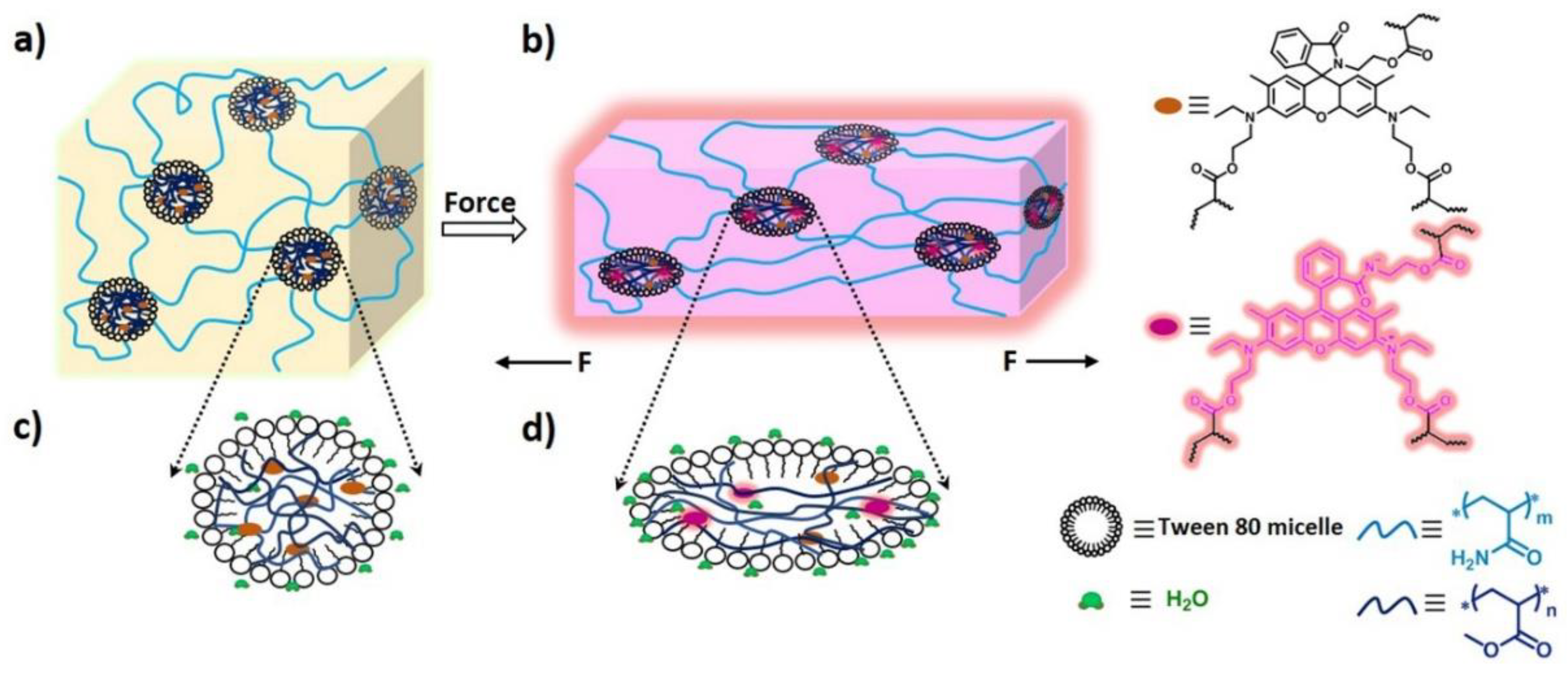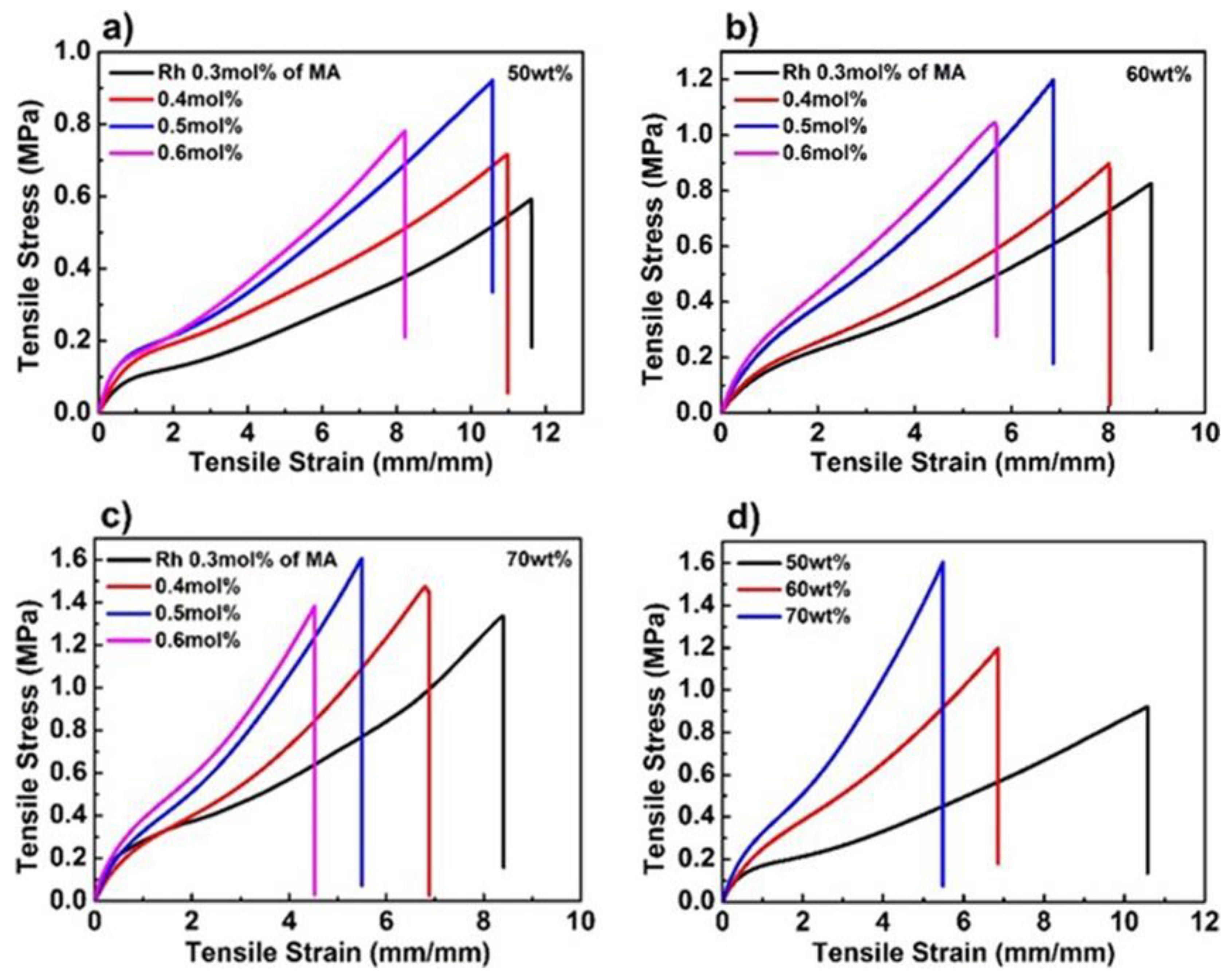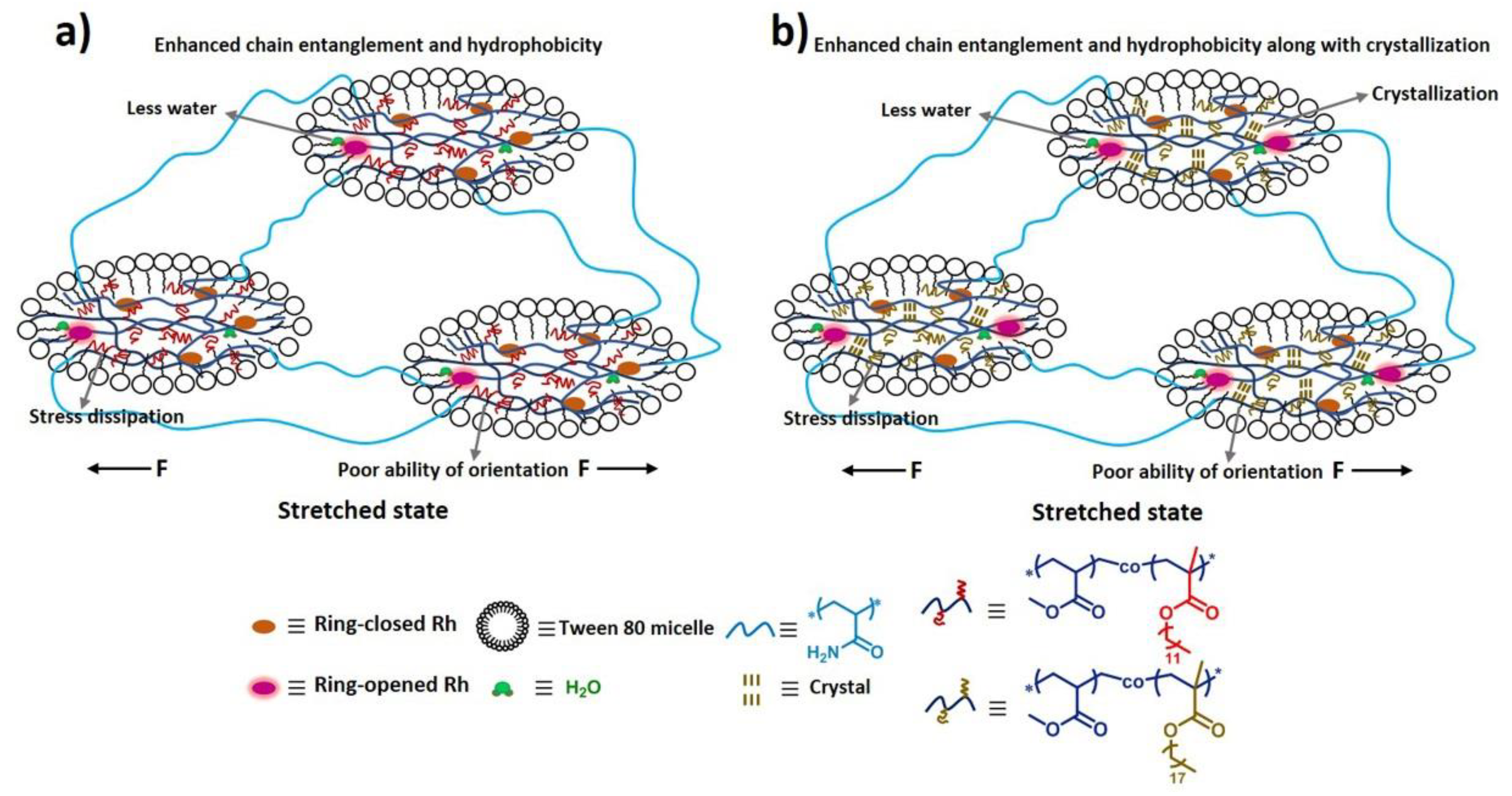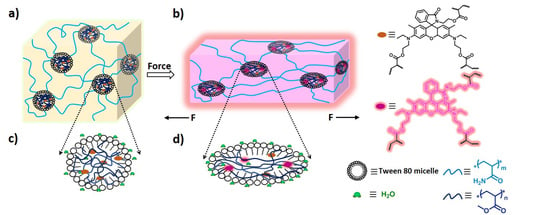Rhodamine-Functionalized Mechanochromic and Mechanofluorescent Hydrogels with Enhanced Mechanoresponsive Sensitivity
Abstract
:1. Introduction
2. Materials and Methods
2.1. Materials
2.2. Synthesis and Preparation
2.2.1. Synthesis of Rh Crosslinker
2.2.2. Preparation of Rh-Based Hydrogels
2.2.3. Preparation of the Control Hydrogels Containing Py
2.2.4. Preparation of Poly(Methyl Acrylate) Containing Py
2.3. Characterizations
2.3.1. Mechanical Characterization
2.3.2. Digital Image Analysis
2.3.3. Fluorescence Spectrometer
2.3.4. Differential Scanning Calorimetry (DSC) Measurements
3. Results and Discussion
3.1. Mechanical Properties of Rh-Functionalized Hydrogels
3.2. Mechanochromic Behavior of Rh-Functionalized Hydrogels
3.3. Mechanofluorescent Property of Rh Functionalized Hydrogels and Fluorescent Detection of Stress/Strain
3.4. Erasable Writing Properties of Rh-Functionalized Hydrogels
3.5. Enhanced Mechanoresponsive Sensitivity within the Micellar Hydrogels
3.6. Acid/Alkali-Responsive Properties of Rh-Functionalized Hydrogels
4. Conclusions
Supplementary Materials
Author Contributions
Funding
Conflicts of Interest
References
- Caruso, M.M.; Davis, D.A.; Shen, Q.; Odom, S.A.; Sottos, N.R.; White, S.R.; Moore, J.S. Mechanically-Induced Chemical Changes in Polymeric Materials. Chem. Rev. 2009, 109, 5755–5798. [Google Scholar] [CrossRef] [PubMed]
- Yan, X.; Wang, F.; Zheng, B.; Huang, F. Stimuli-responsive supramolecular polymeric materials. Chem. Soc. Rev. 2012, 41, 6042–6065. [Google Scholar] [CrossRef] [PubMed]
- Davis, D.A.; Hamilton, A.; Yang, J.; Cremar, L.D.; Van Gough, D.; Potisek, S.L.; Ong, M.T.; Braun, P.V.; Martinez, T.J.; White, S.R.; et al. Force-induced activation of covalent bonds in mechanoresponsive polymeric material. Nature 2009, 459, 68–72. [Google Scholar] [CrossRef] [PubMed]
- Göstl, R.; Sijbesma, R.P. π-extended anthracenes as sensitive probes for mechanical stress. Chem. Sci. 2016, 7, 370–375. [Google Scholar] [CrossRef] [PubMed] [Green Version]
- Balkenende, D.W.R.; Coulibaly, S.; Balog, S.; Simon, Y.C.; Fiore, G.L.; Weder, C. Mechanochemistry with Metallosupramolecular Polymers. J. Am. Chem. Soc. 2014, 136, 10493–10498. [Google Scholar] [CrossRef] [PubMed] [Green Version]
- Beiermann, B.A.; Kramer, S.L.B.; Moore, J.S.; White, S.R.; Sottos, N.R. Role of Mechanophore Orientation in Mechanochemical Reactions. ACS Macro Lett. 2012, 1, 163–166. [Google Scholar] [CrossRef]
- Lee, C.K.; Beiermann, B.A.; Silberstein, M.N.; Wang, J.; Moore, J.S.; Sottos, N.R.; Braun, P.V. Exploiting Force Sensitive Spiropyrans as Molecular Level Probes. Macromolecules 2013, 46, 3746–3752. [Google Scholar] [CrossRef] [Green Version]
- Chen, Y.; Spiering, A.J.; Karthikeyan, S.; Peters, G.W.; Meijer, E.W.; Sijbesma, R.P. Mechanically induced chemiluminescence from polymers incorporating a 1,2-dioxetane unit in the main chain. Nat. Chem. 2012, 4, 559–562. [Google Scholar] [CrossRef] [PubMed]
- Karthikeyan, S.; Sijbesma, R.P. Probing Strain in Thermoplastic Elastomers Using Fluorescence Resonance Energy Transfer. Macromolecules 2009, 42, 5175–5178. [Google Scholar] [CrossRef]
- Filonenko, G.A.; Khusnutdinova, J.R. Dynamic Phosphorescent Probe for Facile and Reversible Stress Sensing. Adv. Mater. 2017, 29, 1700563. [Google Scholar] [CrossRef] [PubMed]
- Crenshaw, B.R.; Weder, C. Self-Assessing Photoluminescent Polyurethanes. Macromolecules 2006, 39, 9581–9589. [Google Scholar] [CrossRef]
- Ramirez, A.L.; Kean, Z.S.; Orlicki, J.A.; Champhekar, M.; Elsakr, S.M.; Krause, W.E.; Craig, S.L. Mechanochemical strengthening of a synthetic polymer in response to typically destructive shear forces. Nat. Chem. 2013, 5, 757–761. [Google Scholar] [CrossRef] [PubMed] [Green Version]
- Bruns, N.; Pustelny, K.; Bergeron, L.M.; Whitehead, T.A.; Clark, D.S. Mechanical nanosensor based on FRET within a thermosome: Damage-reporting polymeric materials. Angew. Chem. Int. Ed. 2009, 48, 5666–5669. [Google Scholar] [CrossRef] [PubMed]
- Song, Y.; Lee, K.; Hong, W.; Cho, S.; Yu, H.; Chung, C. Fluorescence sensing of microcracks based on cycloreversion of a dimeric anthracene moiety. J. Mater. Chem. 2012, 22, 1380–1386. [Google Scholar] [CrossRef]
- Diesendruck, C.E.; Steinberg, B.D.; Sugai, N.; Silberstein, M.N.; Sottos, N.R.; White, S.R.; Braun, P.V.; Moore, J.S. Proton-Coupled Mechanochemical Transduction: A Mechanogenerated Acid. J. Am. Chem. Soc. 2012, 134, 12446–12449. [Google Scholar] [CrossRef] [PubMed] [Green Version]
- Larsen, M.B.; Boydston, A.J. “Flex-Activated” Mechanophores: Using Polymer Mechanochemistry to Direct Bond Bending Activation. J. Am. Chem. Soc. 2013, 135, 8189–8192. [Google Scholar] [CrossRef] [PubMed]
- Wang, Z.; Fan, W.; He, Q.; Wang, Y.; Liang, X.; Cai, S. A simple and robust way towards reversible mechanochromism: Using liquid crystal elastomer as a mask. Extreme Mech. Lett. 2017, 11, 42–48. [Google Scholar] [CrossRef]
- Wang, Z.; Ma, Z.; Wang, Y.; Xu, Z.; Luo, Y.; Wei, Y.; Jia, X. A Novel Mechanochromic and Photochromic Polymer Film: When Rhodamine Joins Polyurethane. Adv. Mater. 2015, 27, 6469–6474. [Google Scholar] [CrossRef] [PubMed]
- Wang, T.; Zhang, N.; Dai, J.; Li, Z.; Bai, W.; Bai, R. Novel Reversible Mechanochromic Elastomer with High Sensitivity: Bond Scission and Bending-Induced Multicolor Switching. ACS Appl. Mater. Interfaces 2017, 9, 11874–11881. [Google Scholar] [CrossRef] [PubMed]
- Woodcock, J.W.; Beams, R.; Davis, C.S.; Chen, N.; Stranick, S.J.; Shah, D.U.; Vollrath, F.; Gilman, J.W. Mechano-Responsive Dyes: Observation of Interfacial Damage in a Silk-Epoxy Composite, Using a Simple Mechanoresponsive Fluorescent Probe. Adv. Mater. Interfaces 2017, 4, 1601018. [Google Scholar] [CrossRef]
- Imato, K.; Kanehara, T.; Ohishi, T.; Nishihara, M.; Yajima, H.; Ito, M.; Takahara, A.; Otsuka, H. Mechanochromic Dynamic Covalent Elastomers: Quantitative Stress Evaluation and Autonomous Recovery. ACS Macro Lett. 2015, 4, 1307–1311. [Google Scholar] [CrossRef]
- Oka, H.; Imato, K.; Sato, T.; Ohishi, T.; Goseki, R.; Otsuka, H. Enhancing Mechanochemical Activation in the Bulk State by Designing Polymer Architectures. ACS Macro Lett. 2016, 5, 1124–1127. [Google Scholar] [CrossRef]
- Imato, K.; Kanehara, T.; Nojima, S.; Ohishi, T.; Higaki, Y.; Takahara, A.; Otsuka, H. Repeatable mechanochemical activation of dynamic covalent bonds in thermoplastic elastomers. Chem. Commun. 2016, 52, 10482–10485. [Google Scholar] [CrossRef] [PubMed] [Green Version]
- Kosuge, T.; Imato, K.; Goseki, R.; Otsuka, H. Polymer–Inorganic Composites with Dynamic Covalent Mechanochromophore. Macromolecules 2016, 49, 5903–5911. [Google Scholar] [CrossRef]
- Chen, Y.; Sijbesma, R.P. Dioxetanes as Mechanoluminescent Probes in Thermoplastic Elastomers. Macromolecules 2014, 47, 3797–3805. [Google Scholar] [CrossRef]
- Kean, Z.S.; Hawk, J.L.; Lin, S.; Zhao, X.; Sijbesma, R.P.; Craig, S.L. Increasing the Maximum Achievable Strain of a Covalent Polymer Gel Through the Addition of Mechanically Invisible Cross-Links. Adv. Mater. 2014, 26, 6013–6018. [Google Scholar] [CrossRef] [PubMed]
- Clough, J.M.; Van der Gucht, J.; Sijbesma, R.P. Mechanoluminescent Imaging of Osmotic Stress-Induced Damage in a Glassy Polymer Network. Macromolecules 2017, 50, 2043–2053. [Google Scholar] [CrossRef] [PubMed]
- Verstraeten, F.; Gostl, R.; Sijbesma, R.P. Stress-induced colouration and crosslinking of polymeric materials by mechanochemical formation of triphenylimidazolyl radicals. Chem. Commun. 2016, 52, 8608–8611. [Google Scholar] [CrossRef] [PubMed] [Green Version]
- O’Bryan, G.; Wong, B.M.; McElhanon, J.R. Stress Sensing in Polycaprolactone Films via an Embedded Photochromic Compound. ACS Appl. Mater. Interfaces 2010, 2, 1594–1600. [Google Scholar] [CrossRef] [PubMed]
- Chen, Y.; Zhang, H.; Fang, X.; Lin, Y.; Xu, Y.; Weng, W. Mechanical Activation of Mechanophore Enhanced by Strong Hydrogen Bonding Interactions. ACS Macro Lett. 2014, 3, 141–145. [Google Scholar] [CrossRef]
- Gossweiler, G.R.; Hewage, G.B.; Soriano, G.; Wang, Q.; Welshofer, G.W.; Zhao, X.; Craig, S.L. Mechanochemical Activation of Covalent Bonds in Polymers with Full and Repeatable Macroscopic Shape Recovery. ACS Macro Lett. 2014, 3, 216–219. [Google Scholar] [CrossRef]
- Li, M.; Liu, W.; Zhang, Q.; Zhu, S. Mechanical Force Sensitive Acrylic Latex Coating. ACS Appl. Mater. Interfaces 2017, 9, 15156–15163. [Google Scholar] [CrossRef] [PubMed]
- Wang, L.; Zhou, X.; Zhang, X.; Du, B. Enhanced Mechanophore Activation within Micelles. Macromolecules 2016, 49, 98–104. [Google Scholar] [CrossRef]
- Li, M.; Lei, L.; Zhang, Q.; Zhu, S. CO2-Breathing Induced Reversible Activation of Mechanophore within Microgels. Macromol. Rapid Commun. 2016, 37, 957–962. [Google Scholar] [CrossRef] [PubMed]
- Chen, H.; Yang, F.; Chen, Q.; Zheng, J. A Novel Design of Multi-Mechanoresponsive and Mechanically Strong Hydrogels. Adv. Mater. 2017, 29, 1606900. [Google Scholar] [CrossRef] [PubMed]
- Baillet, G.; Campredon, M.; Guglielmetti, R.; Giusti, G.; Aubert, C. Dealkylation of N-substituted indolinospironaphthoxazine photochromic compounds under UV irradiation. J. Photochem. Photobiol. A Chem. 1994, 83, 147–151. [Google Scholar] [CrossRef]
- Li, X.; Li, J.; Wang, Y.; Matsuura, T.; Meng, J. Synthesis of functionalized spiropyran and spirooxazine derivatives and their photochromic properties. J. Photochem. Photobiol. A Chem. 2004, 161, 201–213. [Google Scholar] [CrossRef]
- Chibisov, A.K.; Görner, H. Singlet versus triplet photoprocesses in indodicarbocyanine dyes and spiropyran-derived merocyanines. J. Photochem. Photobiol. A Chem. 1997, 105, 261–267. [Google Scholar] [CrossRef]
- Chibisov, A.K.; Görner, H. Photoprocesses in Spiropyran-Derived Merocyanines. J. Phys. Chem. A 1997, 101, 4305–4312. [Google Scholar] [CrossRef]
- Lee, C.K.; Davis, D.A.; White, S.R.; Moore, J.S.; Sottos, N.R.; Braun, P.V. Force-Induced Redistribution of a Chemical Equilibrium. J. Am. Chem. Soc. 2010, 132, 16107–16111. [Google Scholar] [CrossRef] [PubMed]
- Beija, M.; Afonso, C.A.; Martinho, J.M. Synthesis and applications of Rhodamine derivatives as fluorescent probes. Chem. Soc. Rev. 2009, 38, 2410–2433. [Google Scholar] [CrossRef] [PubMed]
- Yang, X.; Huang, Q.; Zhong, Y.; Li, Z.; Li, H.; Lowry, M.; Escobedo, J.O.; Strongin, R.M. A dual emission fluorescent probe enables simultaneous detection of glutathione and cysteine/homocysteine. Chem. Sci. 2014, 5, 2177–2183. [Google Scholar] [CrossRef] [PubMed] [Green Version]
- Kim, H.N.; Lee, M.H.; Kim, H.J.; Kim, J.S.; Yoon, J. A new trend in rhodamine-based chemosensors: Application of spirolactam ring-opening to sensing ions. Chem. Soc. Rev. 2008, 37, 1465–1472. [Google Scholar] [CrossRef] [PubMed]
- Li, M.; Liu, W.; Zhu, S. Smart polyolefins feeling the force: Color changeable poly(ethylene-vinyl acetate) and poly(ethylene-octene) in response to mechanical force. Polymer 2017, 112, 219–227. [Google Scholar] [CrossRef]
- Beiermann, B.A.; Kramer, S.L.B.; May, P.A.; Moore, J.S.; White, S.R.; Sottos, N.R. The Effect of Polymer Chain Alignment and Relaxation on Force-Induced Chemical Reactions in an Elastomer. Adv. Funct. Mater. 2014, 24, 1529–1537. [Google Scholar] [CrossRef]
- Li, M.; Zhang, Q.; Zhu, S. Photo-inactive divinyl spiropyran mechanophore cross-linker for real-time stress sensing. Polymer 2016, 99, 521–528. [Google Scholar] [CrossRef]
- Menger, F.M.; Jerkunica, J.M.; Johnston, J.C. The water content of a micelle interior. The fjord vs. reef models. J. Am. Chem. Soc. 1978, 100, 4676–4678. [Google Scholar] [CrossRef]
- Varadaraj, R.; Bock, J.; Valint, P.; Brons, N. Micropolarity and water penetration in micellar aggregates of linear and branched hydrocarbon surfactants. Langmuir 1990, 6, 1376–1378. [Google Scholar] [CrossRef]
- Arai, N.; Yasuoka, K.; Zeng, X. Self-Assembly of Janus Oligomers into Onion-like Vesicles with Layer-by-Layer Water Discharging Capability: A Minimalist Model. ACS Nano 2016, 10, 8026–8037. [Google Scholar] [CrossRef] [PubMed]
- Li, Z.; Wu, S.; Han, J.; Han, S. Imaging of intracellular acidic compartments with a sensitive rhodamine based fluorogenic pH sensor. Analyst 2011, 136, 3698–3706. [Google Scholar] [CrossRef] [PubMed]
- Stratton, S.G.; Taumoefolau, G.H.; Purnell, G.E.; Rasooly, M.; Czaplyski, W.L.; Harbron, E.J. Tuning the pKa of Fluorescent Rhodamine pH Probes through Substituent Effects. Chem. Eur. J. 2017, 23, 14064–14072. [Google Scholar] [CrossRef] [PubMed]
- Zhang, W.; Tang, B.; Liu, X.; Liu, Y.; Xu, K.; Ma, J.; Tong, L.; Yang, G. A highly sensitive acidic pH fluorescent probe and its application to HepG2 cells. Analyst 2009, 134, 367–371. [Google Scholar] [CrossRef] [PubMed]
- Blasi, P.; D’Souza, S.S.; Selmin, F.; DeLuca, P.P. Plasticizing effect of water on poly(lactide-co-glycolide). J. Control. Release 2005, 108, 1–9. [Google Scholar] [CrossRef] [PubMed]
- Hariri, H.H.; Lehaf, A.M.; Schlenoff, J.B. Mechanical Properties of Osmotically Stressed Polyelectrolyte Complexes and Multilayers: Water as a Plasticizer. Macromolecules 2012, 45, 9364–9372. [Google Scholar] [CrossRef]
- Bilici, C.; Okay, O. Shape Memory Hydrogels via Micellar Copolymerization of Acrylic Acid and n-Octadecyl Acrylate in Aqueous Media. Macromolecules 2013, 46, 3125–3131. [Google Scholar] [CrossRef]
- Zhao, Z.; Liu, Y.; Zhang, K.; Zhuo, S.; Fang, R.; Zhang, J.; Jiang, L.; Liu, M. Biphasic Synergistic Gel Materials with Switchable Mechanics and Self-Healing Capacity. Angew. Chem. Int. Ed. 2017, 56, 13464–13469. [Google Scholar] [CrossRef] [PubMed]










© 2018 by the authors. Licensee MDPI, Basel, Switzerland. This article is an open access article distributed under the terms and conditions of the Creative Commons Attribution (CC BY) license (http://creativecommons.org/licenses/by/4.0/).
Share and Cite
Wang, L.; Zhou, W.; Tang, Q.; Yang, H.; Zhou, Q.; Zhang, X. Rhodamine-Functionalized Mechanochromic and Mechanofluorescent Hydrogels with Enhanced Mechanoresponsive Sensitivity. Polymers 2018, 10, 994. https://doi.org/10.3390/polym10090994
Wang L, Zhou W, Tang Q, Yang H, Zhou Q, Zhang X. Rhodamine-Functionalized Mechanochromic and Mechanofluorescent Hydrogels with Enhanced Mechanoresponsive Sensitivity. Polymers. 2018; 10(9):994. https://doi.org/10.3390/polym10090994
Chicago/Turabian StyleWang, Lijun, Wanfu Zhou, Quan Tang, Haiyang Yang, Qiang Zhou, and Xingyuan Zhang. 2018. "Rhodamine-Functionalized Mechanochromic and Mechanofluorescent Hydrogels with Enhanced Mechanoresponsive Sensitivity" Polymers 10, no. 9: 994. https://doi.org/10.3390/polym10090994





